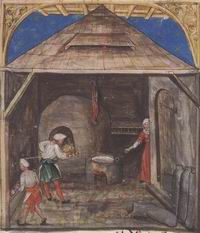Historical depictions, guild signs and symbols of the brewing and malting handcraft
Outlook
This thesis was based on an extensive literature and internet research. In the course of work it was most intriguing, that the image of Pyrprew Herttel [132] was unanimously referred to as the oldest known depiction of a german brewer, yet no source actually proved this or stated, who determined this in the first place. It is surely not possible to have final certainty on "something oldest" - another older image could always be found - however, it is quite unsatisfactory, that seemingly so far no in-depth analysis has been done in this field of study [133] . It is conceivable that the old city and monastery archives contain image treasures yet to be found. Regensburg, in which the beer sign was mentioned already before the 14th century [134] , and one of the oldest settlements in Germany [135] should have some material in this respect.
Another possible point of research are the "Schachzabel" books. These volumes contain images which depict the wordly order and class system through the game of chess. The pawns in the game are quite often farmers or craftsmen. As chess came to Europe before the 2nd millenium, the oldest of these books might contain older images of brewers.
Abb. 37: Bäcker
(und Brauer?),
15. Jahrhundert, Behaim-Codex, Krakau
Above picture shows a baker at work. Next to him, a fired kettle with rings for carrying (as in the Herttel image). The explanations on the behaim codex say anything on the kettle, but why should a baker have a heated kettle next to the stove? It surely was not necessary for baking. As described in this thesis, baking and brewing was often combined - many bakers brewed themselves. Both used yeast as raw material. Maybe this image hence shows a baker, who was also brewer.Maybe there are other pictures, which have to be reevaluated on the basis of guild-connections. Plenty of work for research.
The analysis on the brewing star is also not finished. It would be interesting to know, what the original meaning of the hexagram was and how the various meanings in mideval times came into existence. Apart from that, the actual connection (if any) of brewing and alchemy should be researched, another vast field of study.
| previous chapter |
[132] Siehe Abbildung 7
[133] Dr. Artur Dirmeier vom Katharinenspital Regensburg äußerte sich in einer eMail and den Autor dieser Arbeit ähnlich
[134] Vgl. Kapitel 4.2
[135] Castra regina in römischer Zeit. Die älteste deutsche/römische Brauerei (ca. 200 n. Chr., gefunden bei Ausgrabungenn im Jahre 1978) findet sich ebenfalls in der Nähe von Regensburg. (Irene Krauß, S. 54)
